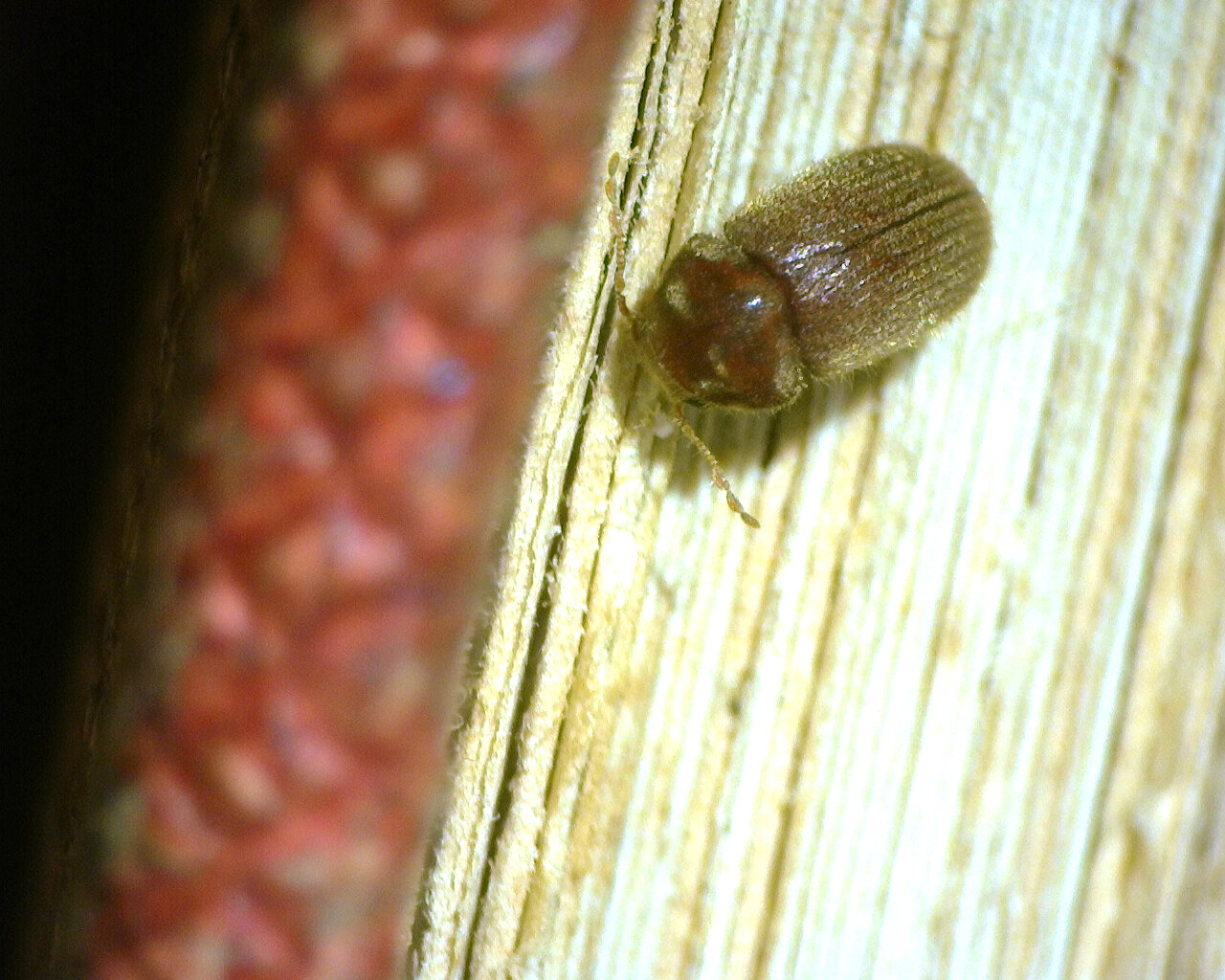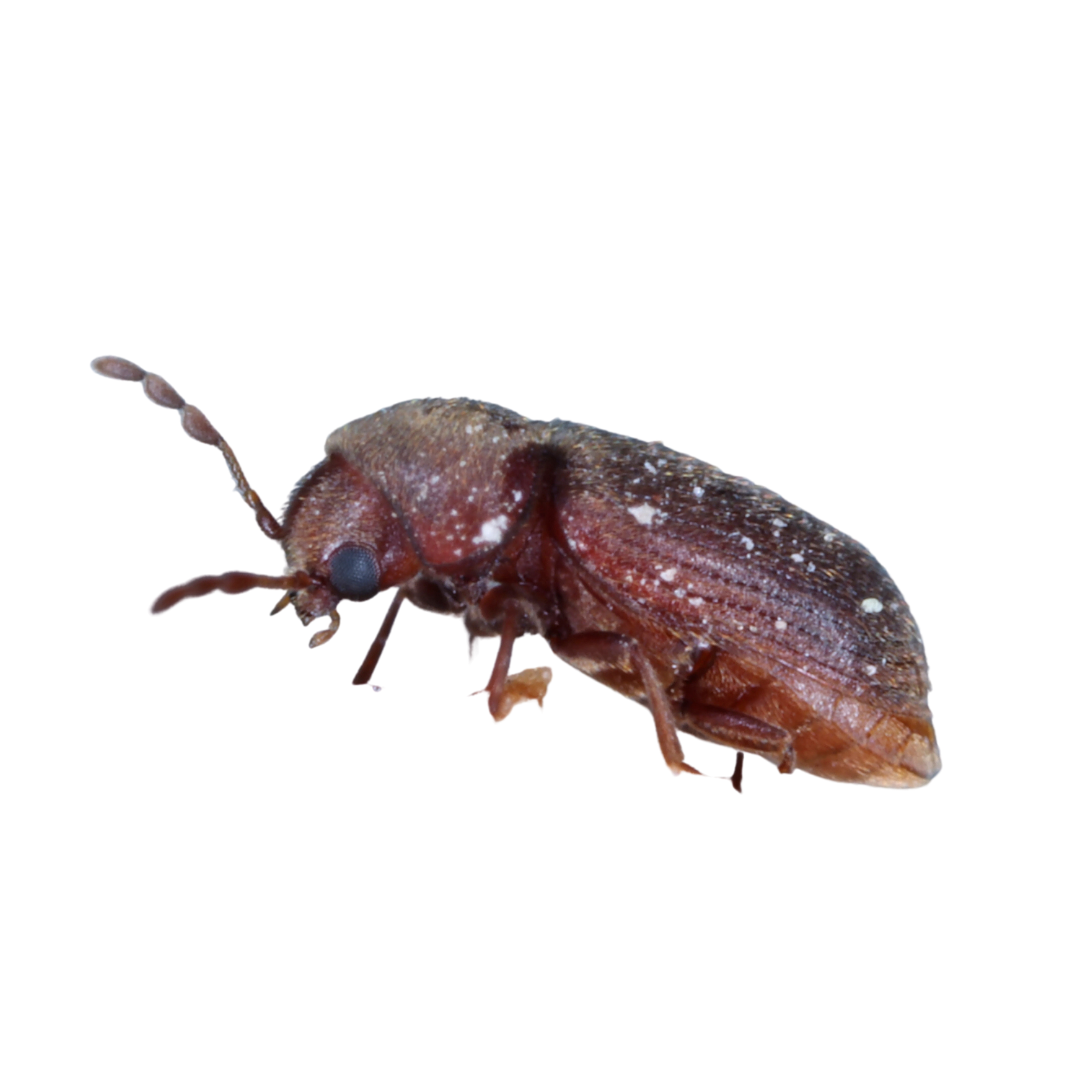Drugstore Beetle (Stegobium paniceum)



Drugstore Beetle Description
Adults: Up to 3.2 mm (0.125 inches) long, brown to reddish brown. Similar in appearance to Cigarette beetles but has several rows of pits (striated) on hairy elytra (hardened wings). The last three antennal segments are slightly enlarged and elongated.
Eggs: Not readily visible without magnification. Eggs are slightly oval in shape, whitish in color, satin to glossy sheen, and approximately 0.2-0.5 mm (0.019 inches) long.
Larvae: Creamy white, C- shaped, slightly hairy, with a large distinct head, and three pairs of thoracic legs.
Pupae: Pupal cases whitish; inside a pupal chamber within food material.
Drugstore Beetle Life Cycle
The female beetle will lay eggs in almost any dry organic substance. Larvae will tunnel through the food substance for about 4-5 months. The life cycle on average is seven months but can be as short as two months. Several generations can occur per year depending on storage conditions.
Drugstore Beetle Damage & Detection
Packages or food items infested with these beetles usually have shot holes where adults have emerged from pupation. Adults and larvae cause damage. Adults are excellent fliers and are attracted to lights.
The use of pheromone traps and inspections can determine the location and degree of Drugstore Beetle infestation. These beetles are commonly found in processed foods such as spices, flour, meal, and dog food, but can also attack horn, wool, hair, pharmaceuticals and even book bindings. It is a common household pest.
Drugstore Beetle Facts
Commonly confused with cigarette beetles (Lasioderma serricorne) and common furniture beetles (Anobium punctatum).
Other common names include biscuit beetle, bread beetle, library beetle, spice beetle, and bakery beetle.
Drugstore beetles initiate flight at temperatures above 20°C (68°F).
Drugstore beetles carry a symbiotic yeast that assists in digestion of less nutritious foods and can provide resistance to certain toxins.
The pheromone that attracts Drugstore beetles also attracts the common furniture beetle (Anobium punctatum).
Drugstore Beetle Monitoring Tips & Tricks
Drugstore Beetle Monitoring Guidelines
Lure
Hiresis Drugstore beetle lures. Contains sex pheromone to attract male beetles.
Lure Storage
Keep unopened lures in cool storage less than 16°C (60°F) or place in the freezer for extended storage.
Trap Designs Used with Lure
Hiresis Drugstore beetle traps and lures are manufactured by Fuji Flavor Co., LTD. and are designed to be hung or placed on a flat surface depending on the situation and structure availability.
Drugstore Beetle Pheromone Trap
Take This Information With You
Drugstore Beetle FAQs
How to get rid of Drugstore Beetles?
The use of pheromone traps for drugstore beetles can indicate their presence as well as where the beetles are coming from. The adult beetles are also highly attracted to insect light traps and can be monitored using these devices.
A visual inspection of dried food or spices in the vicinity of the pheromone traps or light traps containing the most beetles can reveal specific items containing larvae, pupae and adult beetles. Once an infestation is found, the infested materials should be sealed up and discarded or treated to kill the drugstore beetles.
Treatment options for drugstore beetles includes freezing for 1 week, such as with these insect freezer treatment bags, or having a certified pest management specialist perform an anoxic treatment on the infested materials.
What do Drugstore Beetles eat?
Drugstore beetles, Stegobium paniceum are also called biscuit beetles in many parts of the world. Drugstore beetles can eat a very wide range of materials such as flour, meal, dog food, and many types of processed food, but can also attack horn, wool, hair, pharmaceuticals and even book bindings. It is a common household pest.
What is the life cycle of Drugstore Beetles?
The female beetle will lay eggs in almost any dry organic substance. Larvae will tunnel through the food substance for about 4-5 months. The life cycle on average is 7 months but can be as short as 2 months. Several generations can occur per year depending on storage conditions.
Join Our Informed Community
Receive the latest industry updates as they are published.


